
© Railway Wonders of the World 2012-


Electric Locomotive Classification - 1
How Engineers Have Modified the Whyte System and the Various Wheel Arrangements in Service: The American Practice
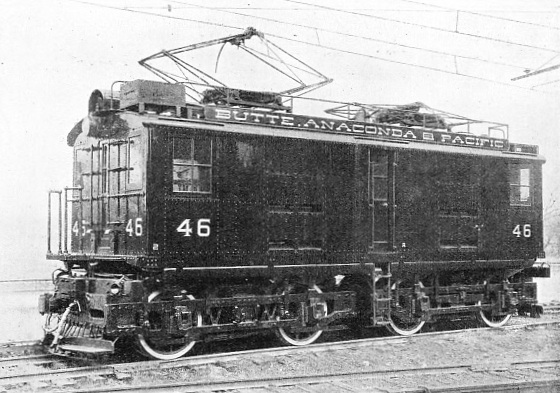
A 2,400-
WHEN electricity first set out to dispute the supremacy of steam traction it was generally believed that the Whyte system of classification, which had proved so conspicuously successful for denoting the type of established locomotive, might be effectively applied to the electric rival. But the vast difference between the two forms of power and the opportunity to “ring the changes” upon the arrangement of the wheels were found to be so extensive as to lead, within a very short time, to the production of a bewildering array of types incapable of ready, comprehensive identification by the time-
The electric differs very markedly from the steam locomotive. Whereas the latter is a self-
generating station placed at a central point. Consequently the electrical locomotive engineer has many overwhelming advantages over his steam colleague. He is not trammelled with such factors as cylinders, boiler, fire-
Furthermore, the method of transmitting the power to the driving wheels is much more diverse. A motor may be mounted on each axle either to drive direct or through gearing, as if, in the steam engine, a pair of cylinders were connected to each driver; or one motor can be adapted to actuate a group of driving wheels through the conventional side-
Realizing the futility of attempting to apply the Whyte system of classification, pure and simple, to the electric locomotive, European manufacturers, by tacit agreement, decided upon a modification of the principle to meet the new conditions in the most comprehensive manner. Simplicity is preserved, with differentiation between the driving and non-
If a motor be mounted upon the axle to drive it independently, then it is expressed by the letter “A”, the first letter in the alphabet, and indicating only one axle; if two axles are coupled then “B”, the second letter, expressing two axles, is used; “C”, the third letter, with three coupled axles in the one frame; “D”, the fourth letter, for four axles; and so on, though the number of driving wheels which can be accommodated in the one frame is as limited in electric as in steam practice.
If the locomotive should have a carrying axle at each end, with a single driving-
It is not only possible to introduce every wheel arrangement known to steam practice into the electric locomotive, but to create an imposing array of further types merely by varying the disposition of the wheels. For instance, the driving wheels may be divided into groups each carried in its own truck, and the latter may or may not be articulated. Consequently the “Duplex”, “Mallet”, “Triplex” and even “Quadruplex” types of steam locomotive may be introduced with ease. Yet, at the same time, it is necessary to indicate this grouping, and that without depriving the classification principle of its cardinal simplicity. This is accomplished readily. If a group of four-
The advantage of this modified Whyte system to meet electric conditions, by the inclusion of alphabetical symbols, which from their position in the alphabet also have a relative numerical value, may be readily illustrated. Take the “Mikado” steam locomotive with its classification 2-
The first designation would denote that the engine had four driven axles, but each carrying its own motor; the second shows that there are four separately driven axles, but disposed in two groups, and, according to the plus sign, the frames are articulated. In the third case we have the same wheel disposition, but without articulation of the frames. The fourth classification indicates that the four drivers are divided into two groups of two coupled axles each, with articulated frames; whereas in the fifth instance we still have this arrangement, but according to the minus sign there is no articulation. Finally we have the four driving axles coupled into the one unit, “D” being the fourth letter in the alphabet, and so we obtain the straight electrical counterpart of the “Mikado” of steam practice.
The foregoing do not exhaust the possible arrangements of the wheels in this single instance, but will suffice for our purpose. Incidentally, it may be mentioned, when setting out the classification in this manner, there is no need to introduce the letter “E” to intimate reference to an electric locomotive; this fact is automatically conveyed by the employment of alphabetical symbols.
In only one respect is it possible to simplify this system, and that is in the case of the direct driven axles. The electric
reproduction of the “Decapod” with five separately driven axles might be just as explicitly expressed “5A” as “AAAAA”, the general method under existing conditions. The former indication of the five separately driven axles, representing the one-
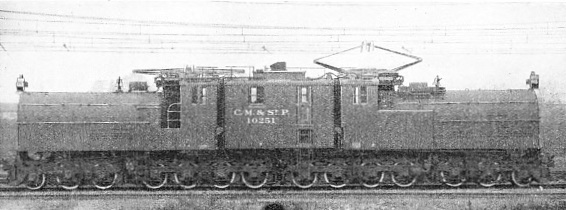
GIANT AMERICAN PASSENGER 3,000-
The foregoing system is acknowledged throughout France, Germany, Italy, Sweden and Switzerland, but with the extensive adoption of electric traction in the United States the domestic manufacturers introduced a new and individual classification. It represents, in principle, the Whyte classification so far as the conditions permit, and is based upon the assumption that every locomotive has three trucks -
Interpreted, the former means that the locomotive has 28 wheels, with a group of six at either end and two groups of eight each in the centre; “E” signifies “electric”, as already explained; “530” gives the weight of the complete locomotive, namely, 530,000 lb; the following combination intimates that there are twelve motors of the General Electric standard type; finally we learn that the conductor carries current at 3,000 volts.
In the second instance we are informed that the locomotive is mounted on 24 wheels, comprising a four-
This classification is unwieldy, and at the same time lacks expressiveness. Thus, in the case of the General Electric loco-
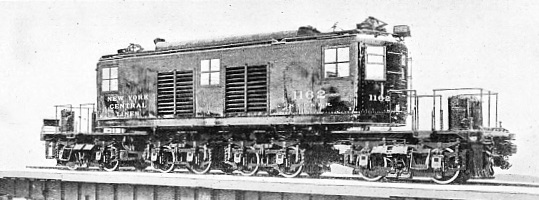
LATEST TYPE OF EXPRESS ELECTRIC LOCOMOTIVE ON THE NEW YORK CENTRAL SYSTEM. It has four trucks, each carrying two axles, with a motor mounted on each axle, and scales 250,000 lb. Its American classification reads: 4444-
In the case of the Westinghouse the information offered is more intelligible, and for this reason it is frequently described as the “double-
The superiority of the European classification system is convincingly demonstrated in this instance. Thereby the 28-
The arrangement even permits direct application of the Whyte system, if desired, by substituting the number of wheels instead of axles as followed in Europe; the reading in this instance would be 4-
Owing to the American classification system being so cumbersome and, to a degree, misleading, it is not meeting with general appreciation, even in the United States, while it is generally ignored outside the country. It is probable that the Whyte system, pure and simple, will prevail, with the index letter “E” to signify electric, though the increasing vogue of the European combined alphabetical and numerical system will possibly lead to its general adoption. Its basic principle successfully precludes all possibility of the electric being confused with the steam locomotive.
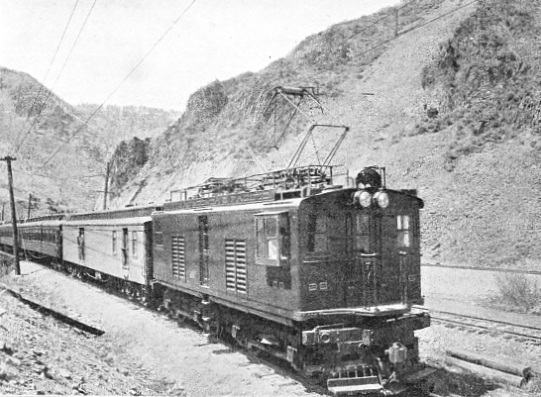
STANDARD PASSENGER TRAIN ON THE BUTTE, ANACONDA AND PACIFIC RAILWAY. The average passenger train consists of one mail and baggage coach, and two to four coaches, and is hauled by a 0-
One of the first successful main line electrification schemes to be completed was that of the Butte, Anaconda and Pacific Railway, running between Butte and Anaconda in Montana. This American road, although only 25·7 miles in length, but with sidings and double track aggregating 122 miles, handles an enormous volume of traffic, the bulk of which is mineral -
Each motor develops 300 horse-
The electric fleet of this system has displaced 27 steam-
The whole of the steam locomotive equipment has been abandoned, and, although the schedule timing for the passenger trains has not been reduced, though easily feasible under electric conditions, there has been an immense saving of coal. This is a matter of primary importance to this district, since all mineral fuel has to be hauled at least 400 miles, and costs the railway approximately 17s. 6d. per ton delivered. Not only are the electrics, under “double-
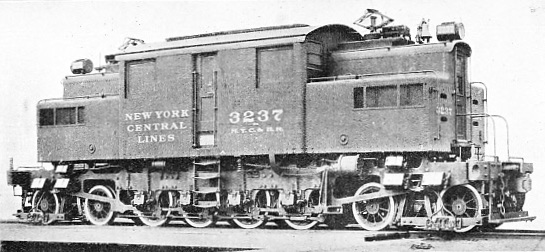
AN EARLY 4-
As the result of the terrible calamity with appalling loss of life which befell an express in the tunnel approach to New York City, owing to the signals being obscured by smoke and steam from passing trains, the New York Central and Hudson River Railroad was compelled to convert the approach from steam to electric working. A certain period was set down for the carrying out of the statutory obligation. This involved the conversion of 54 miles of route -
The first electric locomotives were of the 2-
Increasing train weights and the subjugation of the grade of 1 in 100 commencing from the terminal demanded greater starting effort, which, in turn, compelled the use of larger, heavier and more powerful locomotives of quite a new and original type -
The body is supported on the two central trucks, the nose at either end projecting over the inner axle of each “driving-
The total weight of the locomotive is 250,000 lb, and the whole of this is available for adhesion. Under continuous rating the locomotive develops 2,000 horsepower and a tractive effort of 14,000 lb, capable of being increased for one hour to 2,600 horse-
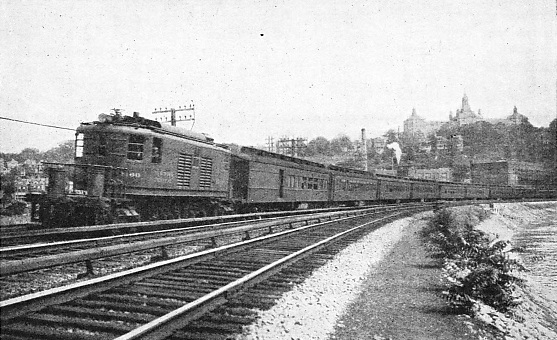
NEW YORK CENTRAL “20TH CENTURY LIMITED”. This luxurious nine-
These locomotives haul the Empire State Express, the famous New York Central “Limited,” a nine-
The New York, New Haven and Hartford Railroad has running powers over nine miles of the New York Central tracks to enter the city terminal, and, as the last-
The electrification of the approach to New York City and the Grand Central terminus has bestowed one overwhelming advantage upon the community, and has reacted to the advantage of the railway company. Under steam conditions the terminal yard was a dreary open depression in the heart of the city, whence rolled immense volumes of steam and smoke the livelong day from the scores of locomotives engaged in the multifarious duties incidental to a large humming terminal. It was an eyesore, while the value of the ground thus occupied represented millions sterling. With electrification the New York Central decided to rebuild the station, and to turn the many benefits accruing from the use of the alternative energy to full account.

MAIN LINE ELECTRIC FREIGHT LOCOMOTIVE AND TRAIN ON THE NEW YORK, NEW HAVEN AND HARTFORD RAILROAD. This Baldwin-
An imposing station has been raised and the tracks have been disposed in two tiers -
The most ambitious and comprehensive main line electrification scheme yet carried out in the United States is that of the Chicago, Milwaukee and St. Paul Railway. This embraces the Rocky Mountain and Cascade Mountain divisions of the line converted to this form of power, aggregating 646 miles of route and 858 miles of track. The power units are among the largest and most powerful yet designed. They are capable of moving passenger trains, composed of 12 to 14 steel coaches, over the heaviest banks rising 1 in 45·4, and, in exhibition speed tests, have notched 83 miles per hour.
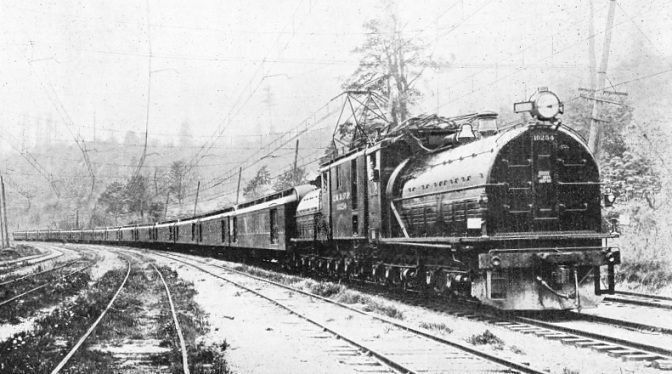
THE “SILK TRAIN” EN ROUTE SEATTLE TO NEW YORK. Cargoes of silk imported from China are landed at Seattle, loaded into a 15-
One of the most notable and interesting movements is the “Silk Train”, so-
To determine the precise supremacy of the electric over the steam locomotive, many interesting-

A NOVEL TEST FOR TRACTIVE EFFORT. A 265-
The spectacle was impressive. The “Mallet” coughed and snorted, belching a huge plume of smoke and steam high into the air, the while the motors of the electric droned monotonously. The driver of the “Mallet” let his engine “all out”, but in vain. Instead, although he crowded on every ounce of steam, he found it impossible to hold his ground.
For a few seconds the two power units locked tightly together stood still; then the electric gaining the upper hand, the ponderous powerful “Mallet” was slowly but surely forced backwards. The steam unit was given every opportunity to excel; the rails were liberally sanded to prevent the driving wheels from slipping, but the continuous rotary torque of the electric proved overwhelmingly superior to the reciprocating and pulsating torque of the steam giant. The latter was further handicapped by having a much larger percentage of its weight supported on idle wheels, whereas in the case of its rival twelve out of its fourteen wheels are drivers.
Another demonstration of a vastly different character was carried out to prove the possibilities and efficiency of regenerative braking. Two steam locomotives, the one a high-
The steam engines were given “full steam ahead”, but to no avail. All the excess power applied over and above that required to maintain 25 miles an hour was absorbed by the motors -
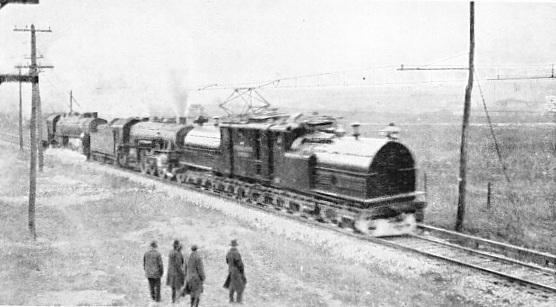
ELECTRICITY VERSUS STEAM. To demonstrate the efficiency of regenerative braking, one of the Chicago, Milwaukee and St. Paul’s gearless passenger locomotives was coupled to two giant steam locomotives. When a speed of 25 miles per hour was attained, the regenerative brake of the electric was put on and the other two driven at full steam in an effort to push the electric beyond that speed. It failed: the 25 miles per hour was maintained and the excess power returned to the power-
You can read more on “Electric Locomotive Classification 2”, “Electric Traction”, “Electrification in Europe” and “Electrification Overseas” on this website.